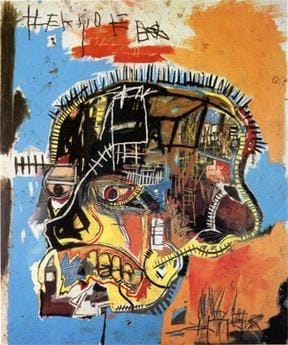Jean-Michel Basquiat was a renowned artist whose work has left an indelible mark on the art world.
His iconic paintings and drawings are a testament to his creative vision and unique style. His works have been exhibited in galleries around the world, and many can be seen in museums to this day. In 2018, one of his paintings became the most expensive work of art ever sold at auction.
In this article, we invite you to explore the art of Jean-Michel Basquiat. We will look at his life and artistic career, his legacy, and how he has influenced the art world today. We will also take a closer look at some of his most famous works and discuss how they reflect his own personal style and interests.
The Early Life of Jean-Michel Basquiat

Jean-Michel Basquiat was born in Brooklyn, New York, in 1960. As an adolescent, he and his friend Al Diaz created a graffiti group called SAMO© and painted messages on walls throughout the city. These messages were critical of consumerism, philosophy and religion.
Basquiat’s work began to draw attention from various New York art dealers and collectors by the late 1970s, and in 1981 his first solo exhibition was held at the Annina Nosei Gallery. The exhibition consisted of works that included brightly colored paintings with images of faces, bodies and words that were thought-provoking and often political.
Basquiat’s star continued to rise throughout the 1980s with numerous exhibitions around the world. His work made use of a variety of materials including acrylic paint, oil stick and ink; combining influences from pop culture, advertisement, graffiti and abstraction to create works that had never been seen before.
Distinguishing Features of Basquiat’s Art
Jean-Michel Basquiat is known the world over for his distinctive and expressive style of art. His works are often characterized by the use of text, inspired by the sampling of contemporary music and archival items. He is particularly renowned for his bright, often jarring color palettes, which created a visual impact that was impossible to ignore.
Basquiat’s works are also noted for their complex layering of symbols. These symbols range from comic book-inspired artwork to African masks and hatchets, which evoke feelings of sorrow in his work. As he incorporated more of these symbols into his work, their meanings slowly evolved and became more abstract – reflecting his own personal psychic landscape at the time.
This layering also serves as a reflection of Basquiat’s complex identity as an artist. Through the use of street graffiti and pop art sensibilities, he embraced a wide range of cultures and created an ever-evolving patchwork quilt of his true self. Ultimately, this made it possible for viewers to interpret his artwork in completely unique ways every time they looked at it.
Political and Social Messages in Basquiat’s Art
Jean-Michel Basquiat’s works are known not only for their vibrant colors and abstract forms, but also for the political and social messages they convey. Through his art, he was able to express his feelings about a wide range of topics such as racism, poverty and colonialism.
For instance, in one of his most famous artworks, “Defacement (The Death of Michael Stewart),” Basquiat expresses his anger about the unjust death of Michael Stewart, a black American artist who died at the hands of New York police officers in 1983. The painting features three figures that represent justice – an angel, a judge and a policeman – as well as a skeleton laying on the ground. The words “defacement,” “police” and “blame” appear throughout the painting.
In other works like “Irony Of A Negro Policeman” and “Hollywood Africans” Basquiat used irony to expose the hypocrisy around racism. His works were filled with symbols that pointed to America’s painful history of slavery. He also explored themes of identity and belonging in pieces such as “Young Kings” which depicted two crowned heads wearing traditional African hats.
By using his art to share powerful messages about society’s injustice, Basquiat was able to spread awareness on issues that were often overlooked by mainstream media. In doing so, he managed to create an entire body of work that is still relevant today while inspiring generations of contemporary artists.
Recognizing Influences on Basquiat’s Art
Jean-Michel Basquiat’s artwork has been recognized for its vibrancy and use of line, but it is also worth noting the influences that shaped his masterpieces. Everywhere you look in his oeuvre, you can see traces of a variety of artists, movements and topics.
Primitivism
Basquiat often referenced primitivism in his work by incorporating African masks, symbols and motifs. He found this style compelling due to its mysterious and symbolic elements. Additionally, he used multiple references to ancient Egyptian culture, which further drew on the idea of primitivism.
Graffiti Writing
Basquiat was exposed to graffiti art at a young age when he was tagging trenchess in Brooklyn in the late 70s. His art featured many elements adapted from New York street art; including symbols and characters that that graffiti writers used to express their messages.
Pop Art
Basquiat’s artwork was also inspired by pop art – most notably Warhol’s iconic Campbell’s Soup Cans. He often incorporated cartoon characters into his works, such as Mickey Mouse or Superman. He also mimicked Warhol’s silkscreen technique as well as his exploration into themes of consumerism, celebrity and fame.
The combination of all these influences created a unique style that has won admiration from critics and fans around the world.
Understanding the Criticism of Basquiat’s Art
The art of Jean-Michel Basquiat has been the subject of much debate in the art world, with many critics feeling that his works lack sophistication and depth. It has been argued that his pieces often feel rushed and lacking in detail or nuance, relying too heavily on basic sketches instead of a more developed technique.
Basquiat’s artwork has been referred to as ‘illustrations’ which can be interpreted as an oversimplification of his work. However, it should be noted that this is largely due to the fact that his pieces were often created in a relatively short period of time and lacked the benefit of refinement.
Controversy and criticism aside, Basquiat’s work serves as an important reminder for aspiring artists to remain true to their own artistic vision, regardless of societal expectations. His bold brushstrokes have inspired generations of artists who have gone on to explore the complexities and nuances of their own work.
Celebrating the Legacy of Jean-Michel Basquiat
The work of Jean-Michel Basquiat has been celebrated around the world for its boldness, creativity, and energetic use of color. His art is a unique combination of graffiti, pop art, and abstract expressionism that touches on topics like race, identity, and power.
Basquiat’s most famous works are vibrant canvases filled with social commentary and life experiences that speak to a wide range of topics and issues. His painting “Self-Portrait in Three Colors” (1982) is a perfect example of this blend of styles. The piece features striking yellow letters spelling out his name accompanied by symbols and symbols from his Haitian ancestry featuring a figure in yellow holding a baby in red who is cradled by an adult in blue. It is a powerful representation of Basquiat’s cultural heritage.
Basquiat’s legacy is evident even today; his influence can still be seen in the works of many modern day artists. His work serves as an inspiration to many aspiring creatives all over the world who strive to create something distinctive, meaningful and powerful. From galleries to museum exhibitions, his work continues to inspire generations to come with its vibrant colors and captivating imagery.
Jean-Michel Basquiat’s artwork has become iconic, and his legacy will continue to be celebrated for its unique expression of street culture. His bold use of color and collage-style compositions expanded the boundaries of what was possible in art, and his desire to challenge convention and go against the grain made him a beloved figure in the art world.
Basquiat’s art will continue to captivate audiences, both new and old, for years to come. His unique take on the world and his passionate exploration of history, culture and identity will be remembered for generations to come.
